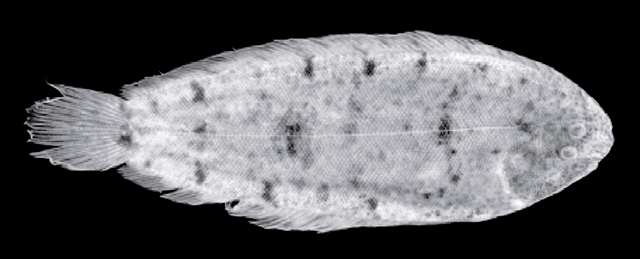| Soleidae (Soles) |
| 6.28 cm SL (male/unsexed) |
|
benthopelagic; freshwater; depth range 1 - 4 m |
| Oceania: Australia, Northern Territory. |
|
Dorsal soft rays (total): 70-77; Anal soft rays: 54-58; Vertebrae: 40-42. This species is distinguished by the following characters: D 70-77; A 54-58; pelvic rays 4 or 5 (usually 4); lateral-line scales 103-111; lateral line on ocular side of head with a ventral branch of 5 to 6 pores, remaining horizontal anterior part with 3-4 pores; vertebrae 40-42; dorsal pterygiophores anterior to fourth neural spine 8-9 (usually 9); body depth 2.95-3.2 in SL; no caudal peduncle; head length 4.45-4.65 in SL; eye diameter 6.35-6.8 in HL; interorbital width 8.6-10.5 in HL; tubular anterior nostril short, only slightly longer than diameter of base, and tapering little; longest dorsal ray 1.8-2.15 in HL; caudal-fin length 4.15-4.7 in SL; pelvic fins and genital papilla not joined, their origins adjacent; pelvic fins short, reaching little beyond base of first anal ray, 2.7-3.1 in HL; colour in alcohol of ocular side brown, faintly mottled with small darker brown spots; with 3 longitudinal rows of dark brown spots, most vertically elongate, the largest two on lateral line; dorsal and anal fins with dark brown streaks on 2-4 adjacent rays; caudal fin with dark brown blotches on base (ref. 84817). |
| Gut material from a 5.85 cm specimen were found to be the remains of hemipteran insects (Ref. 84817). |
|
Not Evaluated (N.E.) Ref. (130435)
|
| harmless |
Source and more info: www.fishbase.org. For personal, classroom, and other internal use only. Not for publication.
